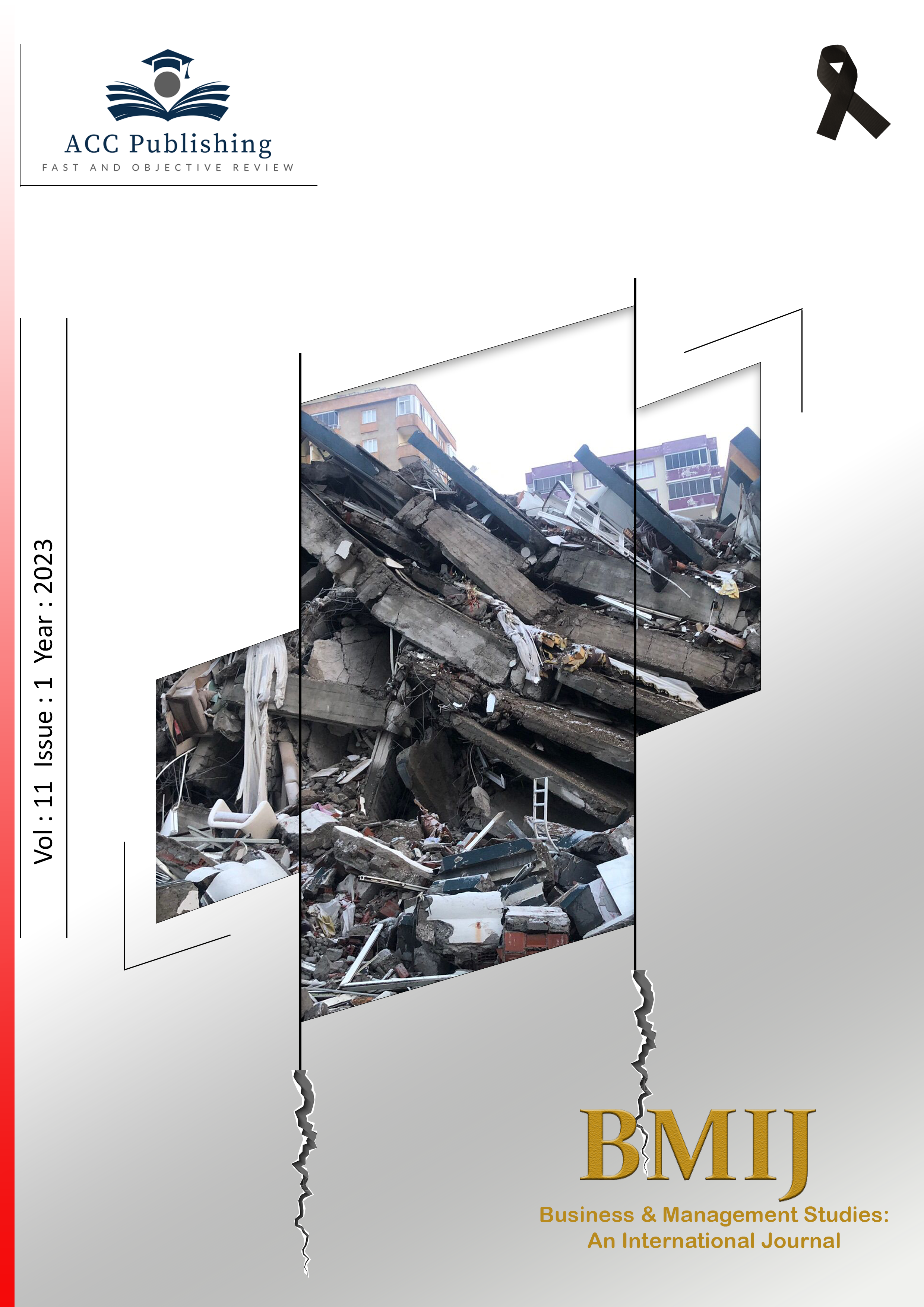
Yayınlanmış 25.03.2023
Nasıl Atıf Yapılır
Telif Hakkı (c) 2023 Mustafa DEĞERLİ

Bu çalışma Creative Commons Attribution-NonCommercial-NoDerivatives 4.0 International License ile lisanslanmıştır.
Nasıl Atıf Yapılır
Öz
Son yıllarda yaşanan COVİD-19 salgını, insanların yaşamlarının ve rutinlerinin çeşitli özelliklerine ilişkin belirgin değişiklikler getirdi. Bu önemli değişimlerden biri, bazı insanların çalışma yerleri ve gelenekleri ile ilgili oldu. Altın ve beyaz yakalıların çalışma biçimleri, şüphesiz son pandemiye karşı uygulanan tedbirler sonucunda değişti. Uzaktan çalışmayı deneyimleyen kuruluşlar ve kişiler, ofislerde çalışma ve evden veya diğer uygun yerlerden çalışmayla ilgili ödünleşimleri değerlendirmek için kapsamlı bir fırsata sahip oldular. Bu makale, altın ve beyaz yakalılar için yeni normal olan hibrit yolu tanımlamakta ve tartışmaktadır. Avantajlar, dezavantajlar, zorluklar ve başarı faktörlerine de bu makalede yer verildi. Bu amaçla, altın ve beyaz yakalı çalışanların yeni çalışma normali ile ilgili deneyimlerini ve görüşlerini almak ve değerlendirmek için bir karma yöntem yaklaşımı izlendi. 2405 kişiden (2365 anket ve 40 görüşme) analiz edilecek ve değerlendirilecek veriler toplandı. Sonuçlar, altın ve beyaz yakalı çalışanlar için yeni normalin hibrit yol (ofislerde çalışmak ve evlerden veya diğer uygun yerlerden uzaktan çalışmanın bir karışımı) olduğu sonucunu desteklemektedir. Dikkate alınması gereken elementler (politika, araçlar ve yönlendirme ile ilgili öğeler) ayrıca makalede tartışılmaktadır. Bu makale, altın ve beyaz yakalı çalışanlar için hibrit çalışma biçimine ilişkin ek kanıtlar ve destek sağlayarak yönetim bilgi birikimine katkıda bulunmaktadır. Çalışanların deneyimleri ve görüşleri ilgili başarıyı ve iyileştirmeleri önemli ölçüde şekillendirdiğinden, bu makale altın ve beyaz yakalı çalışanların yer aldığı kuruluşların yöneticileri, ilgili politika yapıcılar ve yeni normali araştıran diğer araştırmacılar için yararlı olabilecektir.
Referanslar
- Abulibdeh, A. (2020). Can COVID‐19 mitigation measures promote telework practices? Journal of Labor and Society, 23(4), 551–576. https://doi.org/10.1111/wusa.12498
- Anderson, D., & Kelliher, C. (2020). Enforced remote working and the work-life interface during lockdown. Gender in Management: An International Journal, 35(7/8), 677–683. https://doi.org/10.1108/GM-07-2020-0224
- Arora, R. G., & Chauhan, A. (2021). Faculty perspectives on work from home: Teaching efficacy, constraints and challenges during COVID’ 19 lockdown. Journal of Statistics and Management Systems, 24(1), 37–52. https://doi.org/10.1080/09720510.2021.1875567
- Bellmann, L., & Hübler, O. (2021). Working from home, job satisfaction and work–life balance – robust or heterogeneous links? International Journal of Manpower, 42(3), 424–441. https://doi.org/10.1108/IJM-10-2019-0458
- Bhattacharyya, S. S., & Thakre, S. (2021). Coronavirus pandemic and economic lockdown; study of strategic initiatives and tactical responses of firms. International Journal of Organizational Analysis, 29(5), 1240–1268. https://doi.org/10.1108/IJOA-05-2020-2198
- Bolisani, E., Scarso, E., Ipsen, C., Kirchner, K., & Hansen, J. P. (2020). Working from home during COVID-19 pandemic: Lessons learned and issues. Management & Marketing. Challenges for the Knowledge Society, 15(s1), 458–476. https://doi.org/10.2478/mmcks-2020-0027
- Carroll, N., & Conboy, K. (2020). Normalising the “new normal”: Changing tech-driven work practices under pandemic time pressure. International Journal of Information Management, 55(June), 102186. https://doi.org/10.1016/j.ijinfomgt.2020.102186
- Chadee, D., Ren, S., & Tang, G. (2021). Is digital technology the magic bullet for performing work at home? Lessons learned for post COVID-19 recovery in hospitality management. International Journal of Hospitality Management, 92(June 2020), 102718. https://doi.org/10.1016/j.ijhm.2020.102718
- Chattopadhyay, S. (2021). The pandemic of productivity. Anthropology in Action, 28(1), 47–51. https://doi.org/10.3167/aia.2021.280109
- Chong, S., Huang, Y., & Chang, C.-H. (Daisy). (2020). Supporting interdependent telework employees: A moderated-mediation model linking daily COVID-19 task setbacks to next-day work withdrawal. Journal of Applied Psychology, 105(12), 1408–1422. https://doi.org/10.1037/apl0000843
- Choudhury, P. (Raj), Foroughi, C., & Larson, B. (2021). Work‐from‐anywhere: The productivity effects of geographic flexibility. Strategic Management Journal, 42(4), 655–683. https://doi.org/10.1002/smj.3251
- Clark, S., McGrane, A., Boyle, N., Joksimovic, N., Burke, L., Rock, N., & O’ Sullivan, K. (2021). “You’re a teacher you’re a mother, you’re a worker”: Gender inequality during COVID‐19 in Ireland. Gender, Work & Organization, October, gwao.12611. https://doi.org/10.1111/gwao.12611
- Crowley, F., & Doran, J. (2020). COVID‐19, occupational social distancing and remote working potential: An occupation, sector and regional perspective. Regional Science Policy & Practice, 12(6), 1211–1234. https://doi.org/10.1111/rsp3.12347
- Davis, K. G., Kotowski, S. E., Daniel, D., Gerding, T., Naylor, J., & Syck, M. (2020). The home office: Ergonomic lessons from the “new normal”. Ergonomics in Design: The Quarterly of Human Factors Applications, 28(4), 4–10. https://doi.org/10.1177/1064804620937907
- de Lucas Ancillo, A., del Val Núñez, M. T., & Gavrila, S. G. (2021). Workplace change within the COVID-19 context: A grounded theory approach. Economic Research-Ekonomska Istraživanja, 34(1), 2297–2316. https://doi.org/10.1080/1331677X.2020.1862689
- de Macêdo, T. A. M., Cabral, E. L. dos S., Silva Castro, W. R., de Souza Junior, C. C., da Costa Junior, J. F., Pedrosa, F. M., da Silva, A. B., de Medeiros, V. R. F., de Souza, R. P., Cabral, M. A. L., & Másculo, F. S. (2020). Ergonomics and telework: A systematic review. Work, 66(4), 777–788. https://doi.org/10.3233/WOR-203224
- Degerli, M. (2022). Declarations of software engineering project managers managing remotely: Provisions for hybrid working. 2022 3rd International Informatics and Software Engineering Conference (IISEC), 1–5. https://doi.org/10.1109/IISEC56263.2022.9998217
- Delanoeije, J., & Verbruggen, M. (2020). Between-person and within-person effects of telework: A quasi-field experiment. European Journal of Work and Organizational Psychology, 29(6), 795–808. https://doi.org/10.1080/1359432X.2020.1774557
- Diab-Bahman, R., & Al-Enzi, A. (2020). The impact of COVID-19 pandemic on conventional work settings. International Journal of Sociology and Social Policy, 40(9/10), 909–927. https://doi.org/10.1108/IJSSP-07-2020-0262
- Dingel, J. I., & Neiman, B. (2020). How many jobs can be done at home? Journal of Public Economics, 189(January), 104235. https://doi.org/10.1016/j.jpubeco.2020.104235
- Doling, J., & Arundel, R. (2020). The home as workplace: A challenge for housing research. Housing, Theory and Society, 1–20. https://doi.org/10.1080/14036096.2020.1846611
- Duran, S., & Erkin, Ö. (2021). Psychologic distress and sleep quality among adults in Turkey during the COVID-19 pandemic. Progress in Neuro-Psychopharmacology and Biological Psychiatry, 107(January), 110254. https://doi.org/10.1016/j.pnpbp.2021.110254
- Elldér, E. (2020). Telework and daily travel: New evidence from Sweden. Journal of Transport Geography, 86(December 2019), 102777. https://doi.org/10.1016/j.jtrangeo.2020.102777
- Faulds, D. J., & Raju, P. S. (2021). The work-from-home trend: An interview with Brian Kropp. Business Horizons, 64(1), 29–35. https://doi.org/10.1016/j.bushor.2020.10.005
- Field, B., Read, J., Jones, N., Fegan, C., & Lanfranchi, V. (2021). Occupational therapists need to be involved in developing and evaluating technological solutions to support remote working. British Journal of Occupational Therapy, 84(2), 69–71. https://doi.org/10.1177/0308022620979517
- Georgiadou, A., Mouzakitis, S., & Askounis, D. (2022). Working from home during COVID-19 crisis: A cyber security culture assessment survey. Security Journal, 35(2), 486–505. https://doi.org/10.1057/s41284-021-00286-2
- Henry, M. S., le Roux, D. B., & Parry, D. A. (2021). Working in a post Covid-19 world: Towards a conceptual framework for distributed work. South African Journal of Business Management, 52(1), 1–11. https://doi.org/10.4102/sajbm.v52i1.2155
- Herath, T., & Herath, H. S. B. (2020). Coping with the new normal imposed by the COVID-19 pandemic: Lessons for technology management and governance. Information Systems Management, 37(4), 277–283. https://doi.org/10.1080/10580530.2020.1818902
- Hiselius, L. W., & Arnfalk, P. (2021). When the impossible becomes possible: COVID-19’s impact on work and travel patterns in Swedish public agencies. European Transport Research Review, 13(1), 17. https://doi.org/10.1186/s12544-021-00471-9
- Hoffman, C. L. (2021). The experience of teleworking with dogs and cats in the United States during COVID-19. Animals, 11(2), 268. https://doi.org/10.3390/ani11020268
- Holgersen, H., Jia, Z., & Svenkerud, S. (2021). Who and how many can work from home? Evidence from task descriptions. Journal for Labour Market Research, 55(1), 4. https://doi.org/10.1186/s12651-021-00287-z
- Ipsen, C., van Veldhoven, M., Kirchner, K., & Hansen, J. P. (2021). Six key advantages and disadvantages of working from home in Europe during COVID-19. International Journal of Environmental Research and Public Health, 18(4), 1826. https://doi.org/10.3390/ijerph18041826
- Jamal, M. T., Anwar, I., Khan, N. A., & Saleem, I. (2021). Work during COVID-19: Assessing the influence of job demands and resources on practical and psychological outcomes for employees. Asia-Pacific Journal of Business Administration, 13(3), 293–319. https://doi.org/10.1108/APJBA-05-2020-0149
- Javad Koohsari, M., Nakaya, T., Shibata, A., Ishii, K., & Oka, K. (2021). Working from home after the COVID-19 pandemic: Do company employees sit more and move less? Sustainability, 13(2), 939. https://doi.org/10.3390/su13020939
- Kylili, A., Afxentiou, N., Georgiou, L., Panteli, C., Morsink-Georgalli, P.-Z., Panayidou, A., Papouis, C., & Fokaides, P. A. (2020). The role of remote working in smart cities: Lessons learnt from COVID-19 pandemic. Energy Sources, Part A: Recovery, Utilization, and Environmental Effects, 1–16. https://doi.org/10.1080/15567036.2020.1831108
- M, V., Mehrolia, S., Alagarsamy, S., & Balachandran, A. K. (2021). Work from home in the pandemic era: Loss of mental equilibrium? Asian Journal of Psychiatry, 55, 102490. https://doi.org/10.1016/j.ajp.2020.102490
- Matli, W. (2020). The changing work landscape as a result of the Covid-19 pandemic: Insights from remote workers life situations in South Africa. International Journal of Sociology and Social Policy, 40(9/10), 1237–1256. https://doi.org/10.1108/IJSSP-08-2020-0386
- McDowell, C. P., Herring, M. P., Lansing, J., Brower, C., & Meyer, J. D. (2020). Working from home and job loss due to the COVID-19 pandemic are associated with greater time in sedentary behaviors. Frontiers in Public Health, 8. https://doi.org/10.3389/fpubh.2020.597619
- McDowell, C. P., Herring, M. P., Lansing, J., Brower, C. S., & Meyer, J. D. (2021). Associations between employment changes and mental health: US data from during the COVID-19 pandemic. Frontiers in Psychology, 12(February), 1–5. https://doi.org/10.3389/fpsyg.2021.631510
- Mheidly, N., Fares, M. Y., & Fares, J. (2020). Coping with stress and burnout associated with telecommunication and online learning. Frontiers in Public Health, 8(November). https://doi.org/10.3389/fpubh.2020.574969
- Mojtahedzadeh, N., Rohwer, E., Lengen, J., Harth, V., & Mache, S. (2021). Gesundheitsfördernde arbeitsgestaltung im homeoffice im kontext der COVID-19-pandemie. Zentralblatt Für Arbeitsmedizin, Arbeitsschutz Und Ergonomie, 71(2), 69–74. https://doi.org/10.1007/s40664-020-00419-1
- Nguyen, M. H. (2021). Factors influencing home-based telework in Hanoi (Vietnam) during and after the COVID-19 era. Transportation, 0123456789. https://doi.org/10.1007/s11116-021-10169-5
- Oakman, J., Kinsman, N., Stuckey, R., Graham, M., & Weale, V. (2020). A rapid review of mental and physical health effects of working at home: How do we optimise health? BMC Public Health, 20(1), 1–13. https://doi.org/10.1186/s12889-020-09875-z
- O’Brien, W., & Yazdani Aliabadi, F. (2020). Does telecommuting save energy? A critical review of quantitative studies and their research methods. Energy and Buildings, 225, 110298. https://doi.org/10.1016/j.enbuild.2020.110298
- Oliveira, J. (2020). Notes about second homes and teleworking: Comparing Portugal and Norway. Finisterra, 55(115), 139–144. https://doi.org/10.18055/finis20071
- Ollo-López, A., Goñi-Legaz, S., & Erro-Garcés, A. (2021). Home-based telework: Usefulness and facilitators. International Journal of Manpower, 42(4), 644–660. https://doi.org/10.1108/IJM-02-2020-0062
- Palumbo, R. (2020). Let me go to the office! An investigation into the side effects of working from home on work-life balance. International Journal of Public Sector Management, 33(6/7), 771–790. https://doi.org/10.1108/IJPSM-06-2020-0150
- Pranggono, B., & Arabo, A. (2021). COVID‐19 pandemic cybersecurity issues. Internet Technology Letters, 4(2), 4–9. https://doi.org/10.1002/itl2.247
- Raghuram, S., Hill, N. S., Gibbs, J. L., & Maruping, L. M. (2019). Virtual work: Bridging research clusters. Academy of Management Annals, 13(1), 308–341. https://doi.org/10.5465/annals.2017.0020
- Raišienė, A. G., Rapuano, V., Varkulevičiūtė, K., & Stachová, K. (2020). Working from home—Who is happy? A survey of Lithuania’s employees during the COVID-19 quarantine period. Sustainability, 12(13), 5332. https://doi.org/10.3390/su12135332
- Restrepo, B. J., & Zeballos, E. (2020). The effect of working from home on major time allocations with a focus on food-related activities. Review of Economics of the Household, 18(4), 1165–1187. https://doi.org/10.1007/s11150-020-09497-9
- Santana, M., & Cobo, M. J. (2020). What is the future of work? A science mapping analysis. European Management Journal, 38(6), 846–862. https://doi.org/10.1016/j.emj.2020.04.010
- Schur, L. A., Ameri, M., & Kruse, D. (2020). Telework after COVID: A “silver lining” for workers with disabilities? Journal of Occupational Rehabilitation, 30(4), 521–536. https://doi.org/10.1007/s10926-020-09936-5
- Sherman, E. L. (2020). Discretionary remote working helps mothers without harming non-mothers: Evidence from a field experiment. Management Science, 66(3), 1351–1374. https://doi.org/10.1287/mnsc.2018.3237
- Stiles, J., & Smart, M. J. (2020). Working at home and elsewhere: Daily work location, telework, and travel among United States knowledge workers. Transportation, 0123456789. https://doi.org/10.1007/s11116-020-10136-6
- Tanpipat, W., Lim, H. W., & Deng, X. (2021). Implementing remote working policy in corporate offices in Thailand: Strategic facility management perspective. Sustainability, 13(3), 1284. https://doi.org/10.3390/su13031284
- van Nieuwerburgh, C., Barr, M., Fouracres, A. J. S., Moin, T., Brown, C., Holden, C., Lucey, C., & Thomas, P. (2022). Experience of positive psychology coaching while working from home during the COVID-19 pandemic: An Interpretative phenomenological Analysis. Coaching: An International Journal of Theory, Research and Practice, 15(2), 148–165. https://doi.org/10.1080/17521882.2021.1897637
- Wang, W., Albert, L., & Sun, Q. (2020). Employee isolation and telecommuter organizational commitment. Employee Relations: The International Journal, 42(3), 609–625. https://doi.org/10.1108/ER-06-2019-0246
- Zhang, S., Moeckel, R., Moreno, A. T., Shuai, B., & Gao, J. (2020). A work-life conflict perspective on telework. Transportation Research Part A: Policy and Practice, 141(January), 51–68. https://doi.org/10.1016/j.tra.2020.09.007



